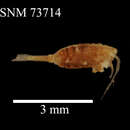Comprehensive Description
provided by Smithsonian Contributions to Zoology
Euchaeta incisa Sars, 1905
MALE.—Body length based on 20 specimens, 4.83– 5.75 mm. Prosome length, 3.50–4.08 mm. Frontal eminence of forehead (Figure 15h) relatively low. Rostrum powerful, pointing straight downward. Posterolateral corners of metasome asymmetrical, each with a small toothlike process dorsally. Antennule reaching about middle of second urosomal segment. Exopod of first leg (Figure 15i) 3-segmented, last two segments each with a well-developed external spine. Endopod of second leg 1-segmented. Exopod (Figure 15;) with external spine of medium size. Incision posterior to second external spine of third exopodal segment moderately deep. Serrated lamella of left fifth leg relatively short. Viewed medially (Figure 15n), toothed edge sigmoidally curved, with four to five large teeth on distal end. Digitiform process of a nearly uniform thickness, with round distal end, and slightly longer than serrated lamella.
DISTRIBUTION.—Euchaeta incisa was originally described from the North Atlantic by Sars (1905) and has been recaptured in the western North Atlantic and the Gulf of Mexico by Grice (1963, 1969). In the present study, a total of 80 females and 20 males were found, mainly in tows down to depths over 1000 m.
- bibliographic citation
- Park, Taisoo. 1975. "Calanoid copepods of the family Euchaetidae from the Gulf of Mexico and western Caribbean Sea." Smithsonian Contributions to Zoology. 1-26. https://doi.org/10.5479/si.00810282.196

